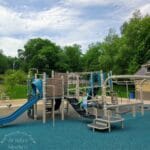Calling all hikers, bikers, and nature lovers! Get ready for an epic adventure at El Corte de Madera Creek Open Space Preserve, a nature lover’s paradise nestled in the Santa Cruz Mountains. With over 34 miles of trails winding through nearly 3,000 acres of pristine wilderness, there’s an unforgettable experience waiting for everyone, from seasoned adventurers to those seeking a tranquil escape. Trek through majestic redwoods, discover hidden sandstone caves, and take in stunning views that will leave you breathless. So, pack your gear, and let’s explore the magic of El Corte de Madera!
Exploring the Redwood Wonderland
El Corte de Madera Creek Open Space Preserve is more than just a park; it’s an immersive journey into nature’s embrace. Imagine stepping into a world where towering redwoods whisper secrets to the wind and the gentle murmur of creeks replaces the clamor of city life. Whether you crave a relaxing afternoon amidst ancient trees or a heart-pumping climb rewarded with panoramic vistas, this preserve caters to every whim and skill level.
The trails themselves weave through a tapestry of diverse landscapes. Meander through shady redwood groves where dappled sunlight creates an ethereal glow, or venture onto sun-kissed hillsides buzzing with the activity of pollinators and fragrant with wildflowers. On a clear day, you might even glimpse the vast Pacific Ocean stretching to the horizon, a testament to the breathtaking scale of the natural world.
But El Corte de Madera is not just a feast for the eyes; it’s a place steeped in history. Its name, meaning “The Cutting of Wood,” hints at the area’s logging past. As you hike, you may stumble upon remnants of this bygone era, offering a poignant glimpse into the lives of those who came before and how their activities shaped this remarkable landscape.
A central feature of the preserve is El Corte de Madera Creek itself, a tributary of San Gregorio Creek. Follow its course and witness the intricate interconnectedness of nature as it nourishes a rich ecosystem of plant and animal life, playing a vital role in the health of the entire watershed.
Planning Your Adventure
Conveniently located near Redwood City and Woodside, with access points off Skyline Boulevard (CA-35), El Corte de Madera is an ideal day trip destination. Before heading out, it’s always wise to check for any trail closures or updates by calling the preserve at +1 650-691-1200.
Key Features of El Corte de Madera Creek Open Space Preserve:
- 3,000 acres of natural wilderness in the Santa Cruz Mountains.
- Over 34 miles of trails for all skill levels and preferences.
- Towering redwoods, tranquil creeks, and diverse landscapes.
- Panoramic views of the Pacific Ocean on clear days.
- Historical remnants of the area’s logging past.
- El Corte de Madera Creek as a central feature, supporting a rich ecosystem.
- Convenient location near Redwood City and Woodside with access from Skyline Boulevard (CA-35).
- An escape from everyday life, offering opportunities for nature immersion and rejuvenation.
Enjoy the immersive experience that defines the vibrant community and premiere entertainment venue. Discover premium coffee and exceptional cuisine at our very own Coupa Cafe. Unleash your spirits and enjoy the city’s favorite crafted beer at Craft 96 Draught.
Understanding Wood Cuts: A Comprehensive Guide
Understanding different wood cuts is essential for any woodworking project. The way a log is sawn dramatically impacts the wood’s stability, appearance, and how it behaves over time. Let’s explore the various techniques, their advantages, and disadvantages.
Types of Wood Cuts
Plain Sawing (Corte Paralelo): This is the most common and economical method. The log is sliced like a loaf of bread, producing the most usable lumber. However, plain-sawn wood is more susceptible to warping, shrinking, and swelling with changes in humidity. The grain pattern varies significantly.
Quarter Sawing (Corte Radial): Like cutting an orange into segments, this method produces boards with a straight, uniform grain, providing exceptional stability and resistance to warping. It beautifully showcases the growth rings but yields fewer boards and is more expensive.
Rift Sawing (Corte de Hilos Encontrados): This cut offers similar stability to quarter sawing but with a linear grain pattern preferred by some for its modern aesthetic. It’s also more costly due to higher waste.
Live Sawing: This technique follows the natural contours of the log, yielding unique slabs with organic shapes and curves, perfect for artistic projects. Each piece reflects the tree’s individual growth history.
Choosing the Right Cut
Selecting the right wood cut depends on several factors:
Wood Species: Different species react differently to various cuts. For example, oak, prone to warping, benefits greatly from quarter sawing.
Project Needs: A sturdy table requires stability (likely quarter sawing), while a decorative shelf might be fine with plain sawing. Budget is also a consideration.
Log Size: Larger logs provide greater flexibility for specialized cuts like rift sawing, while smaller logs may limit options to plain sawing.
Tools of the Trade
The tools used also influence the final outcome:
| Tool | Description | Typical Cut Type |
|---|---|---|
| Circular Saw | Ideal for straight cuts. | Plain Sawing |
| Band Saw | Excellent for curved and resawing cuts. | Varied |
| Table Saw | Versatile for a wide range of cuts. | Varied |
The Wood Cutting Process: From Forest to Finish
The process of transforming raw timber into usable pieces, known as woodcutting, involves more than just sawing. It’s a craft that demands precision and an understanding of different cutting techniques.
Types of Cuts
Crosscutting (Corte transversal): Cutting perpendicular to the wood grain for strength and stability.
Rip Cutting (Corte paralelo): Cutting parallel to the wood grain to reduce warping and enhance grain appearance.
Bevel Cutting (Corte en bisel): Angled cuts along the edge for sloped surfaces.
Miter Cutting (Corte a inglete): Angled cuts on the face for joining pieces at an angle.
Compound Cutting (Corte compuesto): Combining bevel and miter cuts for complex joints.
Tools and Techniques
| Tool | Description | Best For |
|---|---|---|
| Hand Saw | Portable and versatile for detail work. | Small cuts, trimming |
| Circular Saw | Powerful for straight cuts. | Ripping and crosscutting larger pieces |
| Jigsaw | Designed for curved and intricate cuts. | Curves, circles, intricate shapes |
| Miter Saw | Precise for angled cuts. | Joining pieces at angles, molding |
| Table Saw | Stationary and precise for long, accurate cuts. | Ripping, crosscutting larger pieces |
Steps in the Process
Plan and Measure: Accurate measurements are crucial for success.
Choose the Right Tool: The tool should match the cut and wood thickness.
Cutting Technique: Consistent angle and even pressure prevent splintering.
Safety First: Always prioritize safety by wearing appropriate gear.
Minimizing Wood Loss: Understanding Saw Kerf
“Saw kerf” refers to the width of the cut made by a saw blade – essentially, the material lost as sawdust. While seemingly small (typically 3-4mm), it can accumulate significantly, impacting both material costs and project accuracy.
Factors Influencing Kerf
- Blade Thickness: Thicker blades produce wider kerfs.
- Blade Type: Tooth configuration affects kerf width.
- Saw Type: Different saws have varying kerf characteristics.
- Wood Type: Harder woods might necessitate techniques that increase kerf.
- Cutting Technique: A rough cut will likely create more waste.
Some experts suggest calculating for 1cm total loss in both length and height due to trimming and the kerf when considering cuts, especially when striving for precise edges and dimensionally stable projects. While overall lumber loss during harvesting can be as high as 25% (including branches, bark, and milling), saw kerf is a distinct contributor to waste during the woodworking process itself. By recognizing the factors influencing kerf, woodworkers can take steps to minimize loss.
Minimizing Waste
- Sharp Blades: Sharp blades make cleaner, more predictable cuts.
- Proper Technique: Smooth, controlled cuts reduce waste.
- Accurate Measurements: Careful planning minimizes unnecessary cuts.
- Blade Selection: Choose the right blade for the task.
By understanding and accounting for saw kerf, woodworkers can optimize material usage, reduce costs, and ensure project accuracy. Ongoing research continues to explore ways to minimize kerf loss through blade design and cutting techniques, so staying informed about new developments is beneficial.
- Unlocking 2-Letter Words with U: The Definitive Guide - April 4, 2025
- Unlock Words with the Letters THREE: Top Unscramble Tools 2025 - April 4, 2025
- Master Scrabble: X & Z Words for High Scores - April 4, 2025















